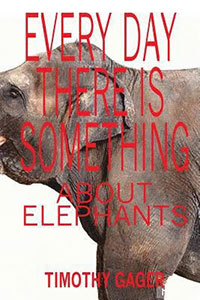 *
*
Here is a review of Somerville writer Timothy Gager’s latest collection of flash fiction: Every Day There Is Something About Elephants (Big Table Publishing)
Review by Leah Brundige
Timothy Gager’s engaging new collection of flash fiction, Every Day There Is Something about Elephants, shows a novelist’s interest in human interactions and vivid details coupled with a poet’s gifts for compression and figurative language. The book’s 107 stories vary in tone, scope, and length, but none is longer than four pages. Some – such as The Lottery Winner, a tour de force at just a page in a half – deploy and develop an extraordinary number of characters relative to their size, while others navigate the constraints on their length by more poetic means, turning on a single pun (Chiller) or extended metaphor (How penguins break). The reader is carried along by their expert pacing and, in many cases, by their sheer shock value. Gager is a master of the twist ending.

The subject matter of these short-shorts is often harrowing, and the author is unafraid to write with sympathy, if not approval, of the seedier sides of human nature and society. Abused or addicted, homicidal or lecherous, his characters command our attention as they grope through their flawed lives toward connection or transcendence. Gager is frugal with his imagery, but he knows how to illuminate a character’s plight with a painful, well-chosen detail when the story calls for it: You burned your lips on a crack pipe, without the warning: The glass on this pipe reaches extreme temperatures. Handle with care. You didn’t care. The blisters popped and fused your lips together.
The gritty realism of that terrible last sentence might seem at first glance to be at odds with another strain that runs through Gager’s work: a domestic surrealism that at times borders on whimsy. The elephant-haunted narrator of the collection’s title story recounts details that at first seem merely absurd (“How did I know an elephant had been in the refrigerator? He left his footprint in the cheesecake”) but become more disquieting as the narrative progresses, until we realize that the “elephants” are manifestations of the character’s mental disturbance. The conclusion brings the elephant metaphor to chilling culmination and unsettles the reader with all that it leaves unsaid. The story recalls Ernest Hemingway’s famous Hills like White Elephants, another piece of short fiction animated by its pachydermal symbolism, though the judicious silences in Gager’s narrative threaten to make Hemingway’s measured withholding of information look like a parlor trick.
If the familiar concerns of Gager’s fiction – domestic violence, firearms, and drinking among them – recur frequently in these stories, they never feel repetitive. Gager’s imaginative resources are considerable, and imbue each piece with its own freshness of character or circumstance. They are stories that, however grim on the surface, rejoice in their own brevity and technique. This immensely readable book affirms the prolific Gager’s literary gifts, and showcases a kind of short story that seems, by the collection’s end, entirely his own.















Reader Comments